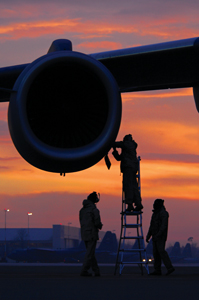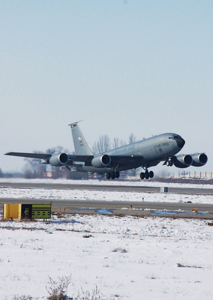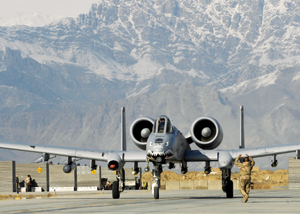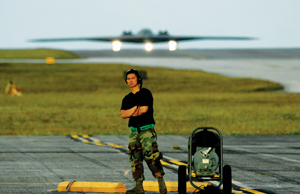Within days of that February announcement, the Kyrgyz parliament followed up with legislation that would end American use of the base. After receiving the eviction notice, Washington had six months to clear out.
 |
USAF airmen perform an engine check on a C-17 at Ramstein AB, Germany. |
Negotiations are continuing, but barring an unexpected change of heart in Kyrgyzstan (the parliamentary vote was 78-to-one), the US will have to find a new air base to support operations in Afghanistan. The timing, from the American perspective, couldn’t be worse. President Barack Obama had recently announced plans to add 17,000 combat troops to the force battling the Taliban and al Qaeda in Afghanistan, a down payment on an expansion that could eventually total 30,000 new US troops. That effort now would have to be reconfigured, if not reconsidered.
The sudden political earthquake that shook Central Asia underscored a fundamental truth about today’s geopolitics. The military might of the world’s lone remaining superpower, awesome as it is, hinges to a remarkable degree on a shrinking and fragile necklace of overseas bases.
With its access to this worldwide network of bases, Washington enjoys a unique position, one that allows US forces to project power and influence far beyond its borders. Yet the US also has much to lose.
The existence of a major overseas US military presence has been a global fact for so long that it is today largely taken for granted. This and the wars in Iraq and Afghanistan have obscured the fact that America has embarked on the most significant realignment of its global military posture since the end of the Cold War some two decades ago.
Bakiyev’s announcement came during the same week that insurgents destroyed a key bridge at the Khyber Pass, a historic choke point in the land route between Pakistan and Afghanistan. Through it travels three-quarters of the US supplies bound for Afghanistan.
It did not go unnoticed that Bakiyev dropped his bomb during a visit to Moscow. Russia promised Kyrgyzstan more than $2 billion in loans and grants. Russian and Kyrgyz officials denied any quid pro quo, but Moscow has made no secret of its desire to get the US military out of Central Asia. And Bakiyev had long complained that the rent the US paid for access to the base was insufficient.
The Air Force transports 15,000 troops and a million pounds of Afghanistan-bound cargo through Manas every month. USAF’s 376th Air Expeditionary Wing at Manas also flies KC-135 tankers, which delivered fuel to more than 11,000 US and NATO aircraft over Afghanistan in 2008.
Gen. Norton A. Schwartz, Chief of Staff, recently called the base a “key location” but added that it was not irreplaceable.
USAF has been operating from Manas since 2001, and since 2005, Manas alone has filled the need for a reliable Central Asian air hub near Afghanistan. That was when the US was kicked out of Karshi-Khanabad (K2) Air Base in Uzbekistan, after human rights tensions with Uzbekistan boiled over.
Washington has a good track record of finding new bases. The US successfully scrambled to find basing within range of Afghanistan after the 9/11 terror attacks, but with the loss of both K2 and Manas, it will have to scramble once again. The threats to US global strategic interests never let up. Other recent challenges in the news include:
Russian threats to station short-range missiles near its old satellites in Eastern Europe in response to proposed US missile defense sites in Poland and the Czech Republic.
Chinese deployments of more surface-to-surface missiles near the Taiwan Strait to threaten bases on Taiwan.
Iraqi parliamentary votes to compel US forces to withdraw from the country by 2011.
 |
A KC-135 takes off from Manas AB, Kyrgyzstan, on Feb. 6, 2009, for a refueling mission over Afghanistan. |
The push for a new global presence and basing strategy may prove one of the most significant legacies of Donald H. Rumsfeld’s second tenure as Defense Secretary during the years 2001-06. The effort began with what was known as the Global Posture Review. It heralded a major shift of US military forces away from traditional Cold War locales to locations better suited to counter threats of Islamic extremist terrorism and tensions in the Western Pacific.
Operations in the Middle East prompted plans to return 70,000 troops to the United States from elsewhere in the world. This was done in part to improve the quality of life of service families left behind during deployments. In all, the 10-year plan called for reducing the US military footprint overseas by 35 percent.
The review heralded a major shift in basing requirements.
The shock of the Sept. 11, 2001 terrorist attacks allowed the US to overcome the inertia of the existing basing arrangements. Between 2000 and early 2002, the US increased its presence in the Middle East and Central Asia from roughly 25,000 to 70,000 troops.
The subsequent basing review took a comprehensive approach, seeking to address the short-term need for more forces in the Middle East, the long-term shift in strategic emphasis from Europe to Asia, and the change from a reliance on heavy, forward deployed forces at fixed bases to leaner, more expeditionary forces and fluid access agreements.
The shift is reflected in operations in Afghanistan and Iraq, and in major new deployments of military forces. The US is actively involved in preventing turmoil in a wide “arc of instability” stretching from North Africa and the eastern Mediterranean all the way through the Caucasus and Pakistan to Indonesia and the Philippines.
The world’s ungoverned spaces are a strategic vulnerability and potential sanctuaries for terrorist groups, so the GPR also called for the establishment of a new Africa Command and an increased military presence on that continent.
The global basing structure the Bush Administration inherited was frozen in the aftermath of 20th century wars, with major concentrations of forces still clustered in Germany, Japan, and South Korea.
“Rumsfeld recognized that the best way forward for American military facilities overseas can be summed up in the bumper sticker, ‘Access, Not Basing,’” said Thomas Ehrhard, a basing expert and senior fellow at the Center for Strategic and Budgetary Assessments.
The difficulty in fully implementing the posture review reveals a dysfunctional political dynamic that impacts basing decisions, said Ehrhard, and which complicates strategic planning.
“Basically, it’s relatively easy to close an overseas base, much harder to close a base inside the United States, and harder still to spend money expanding the basing infrastructure overseas where needed,” said Ehrhard.
“For that reason, the GPR has been pretty successful in demobilization in Europe, less successful in matching US-based forces with the required lift needed to transport them to the fight, and ineffective in expanding, dispersing, and hardening our basing footprint as required in Asia.”
Central Asian drama notwithstanding, the most significant changes thus far have been in Europe. A decade after the Cold War, there were still more than 120,000 US troops stationed in Western Europe—but defending against what
Subsequent changes have been smooth but dramatic. US Air Forces in Europe now operates five main operating bases (plus Incirlik AB, Turkey, which does not host permanently assigned aircraft), down from 25 at the peak of the Cold War. USAFE’s manpower has similarly been cut by more than half since 1990.
 |
An A-10 taxis down a runway at Bagram Airfield, Afghanistan. If the US loses access to Manas, air bases in Afghanistan may pick up more of the USAF mission. |
Bucking the overall trend, USAFE’s large air hubs, such as Ramstein AB, Germany, and Lajes Field in Portugal’s Azores islands, have grown as critical nodes in the air bridge between the US and air bases in the CENTCOM region.
The two heavy Army divisions and 55,000 soldiers in Germany, however, struck the Rumsfeld team as particularly ill-positioned and tactically unwieldy. Not surprisingly, the Army in particular came in for the most fundamental restructuring under the basing review.
The total number of US forces in Europe is dropping to 65,000 by 2012. The number of soldiers has fallen from 70,000 earlier this decade to roughly 47,000 today, with a further decline to 28,000 anticipated.
The Pentagon has also signed 10-year agreements for access to seven flexible “forward operating locations” and “cooperative security locations” in new NATO member states Bulgaria and Romania.
Hard Choices
Under the basing plan, a brigade will periodically rotate to these Eastern European bases on temporary deployments—substituting occasional exercises for more expensive forward presence. The Air Force has already temporarily deployed aircraft and airmen to Romania several times in early tests of this arrangement.
Increasingly tense relations with Russia, including its invasion of Georgia in August of 2008 have given many pause in contemplating further European force reductions, however.
“In addition to plans to keep a Stryker brigade [in Europe], an additional heavy brigade or possibly even two should probably stay as well,” asserted Brookings Institution military analyst Michael E. O’Hanlon in his 2008 report, “Unfinished Business: US Overseas Military Presence in the 21st Century.” The DOD plan to rotate forces through Romania and Bulgaria will “add one more burden” to the Army, he noted.
Some experts fear, however, that the strains of the Iraq war and rising tensions with Russia will be used as excuses to revert to old, comfortable ways and keep excess forces in Europe.
“When you’re a global power like the United States, you have to make hard choices about where you will place limited military forces,” said Ehrhard.
“There is an ‘opportunity cost’ to leaving more forces in Europe, because that means you will have less forces and resources for Asia,” he added. “That’s a dubious strategic proposition.”
China’s meteoric economic growth and rapid military modernization in the past decade have inspired many recent basing decisions. Centerpiece alliances with South Korea and Japan are increasingly seen as vital.
With the strengthening of South Korean forces in recent years, DOD reasoned that the US could safely remove one of two Army combat brigades from the peninsula to free up forces for Iraq and Afghanistan. The US shifted its military footprint in South Korea, pulling US forces away from the Demilitarized Zone where they could be hit by North Korean artillery. The US Forces Korea headquarters is also to be pulled out of Seoul, where it occupied prime real estate and was a political lightning rod in one of Asia’s busiest cities. It will be moved midcountry.
In all, the plan is to downsize the military presence in South Korea from roughly 35,000 to 25,000 troops and to shutter 59 facilities—representing two-thirds of the total acreage US forces occupy in South Korea.
In Japan, the major change is the coming reduction—by about half—of the 15,000 marines on Okinawa. The heavy military presence there has long been an irritant in US-Japanese relations, so roughly 8,000 marines are scheduled to relocate to Guam.
Other locations in Japan are seeing their capabilities bolstered, and Kadena Air Base on Okinawa is increasingly a lynchpin in America’s Pacific military presence.
The Pentagon also seeks to secure secondary facilities, access agreements, and military-to-military relationships elsewhere in the region, most notably with Thailand, Singapore, the Philippines, and Australia.
If the blueprint for Asia outlined in the Global Posture Review seems generally sound, a number of experts note problems in the execution. Rumsfeld’s brusque style famously riled South Korean leaders—some of whom were convinced that Rumsfeld intended to use the GPR as cover for a complete withdrawal from their country.
“Alone among the world’s major powers, the United States today has … enough capability in numerous strategically important parts of the world to make a difference in normal day-to-day regional balances of power,” stated O’Hanlon. “Not only does the United States have a great deal of firepower stationed abroad, it has the infrastructure, the working relationships, and the transportation and logistics assets needed to reinforce its capacities quickly as needed in crises.”
Rumsfeld may have unnecessarily irritated the South Korean leadership, but “moving US forces south from the Korean DMZ and out of Seoul; shifting marines to Guam from Okinawa to ease US-Japanese tensions; and hedging against a rising China all make sense from a practical perspective,” said O’Hanlon.
The recent DOD attention to access in the Pacific may still be insufficient. A wargame recently run by Pacific Air Forces suggests that the Pentagon may have to go further to adequately check a rising China. Leaders of the Pacific Vision exercise concluded that more needs to be done to negotiate Pacific access agreements, further disperse US military assets to complicate an adversary’s targeting challenge, and harden aircraft hangars, command posts, and ammunition depots in the region against potential attack.
Even if those steps are taken, possible weak links exist in the US military’s posture in Asia. Because of the vast distances involved, more aerial refueling tankers are needed in the Pacific; however, attempts to modernize have seemingly hit a brick wall.
China’s demonstrated ability to destroy an inactive satellite with a missile, and its focus in recent years on cyber warfare, also suggest that US satellite communications systems, radar networks, and computer grids in the Pacific region are vulnerable.
China is “increasing the range and lethality of its anti-access weapons in fairly dramatic fashion, meaning its ‘threat ring’ in Asia now holds at risk a lot of our land- and sea-based forces in the region,” said Ehrhard. “That means the United States needs more hardening of military facilities, greater dispersal of forces, better warning systems, as well as active and passive defenses. All of those steps carry costs. So while Americans would rather this strategic threat didn’t exist at a time when we have so many other problems on our plate, to simply let our current basing network in Asia atrophy will only provoke China.”
 |
A1C Sunny Ventura, 36th Expeditionary Maintenance Squadron, checks the horizon for the arrival of a second B-2 Spirit at Andersen AFB, Guam. |
The Singapore Model
Singapore is often held up as a model for the “lily pad” type of arrangement the US needs more of. American forces in Singapore are “small in number and low in profile,” noted Kent E. Calder in his 2007 book, Embattled Garrisons: Comparative Base Politics and American Globalism. Yet the infrastructure there, “including ports, airfields, repair facilities, hospitals, and communications, is first rate.” Pre-positioned equipment stocks mean that “in the event of a regional contingency, a smooth, rapid buildup would be easy to achieve.”
Developing additional expeditionary locations along the “Singapore Model” will minimize the chance that the US will lose strategic access because of host-nation restrictions, enemy attack, or politics—as was the case at Manas.
“If a military base boasts a Burger King or a Taco Bell, then it probably represents the old way of basing,” said Ehrhard. “In the future, we need more fluid access agreements for expeditionary forces that can be activated—or not—depending on how threats develop.”
Securing access has never been easy, even when dealing with longtime allies.
With the Cold War still raging, the US was ordered out of two NATO air bases in 1988. First to go was Torrejon AB, Spain, followed by Hellenikon Air Base in Greece.
In 1991, the eruption of Mount Pinatubo hastened the end of Clark Air Base in the Philippines. At the time, Clark was among the largest of overseas USAF operating locations—but it was also a political hot button between the US and Philippine governments.
Then, in 2003, NATO ally Turkey refused to allow its territory as a transit point to open the northern front for Operation Iraqi Freedom.
Each of these incidents was difficult to deal with, but the Air Force has proved time and again its ability to adjust. Indeed, in 2004, Col. Mike Sumida, then the vice commander at Manas, told the Christian Science Monitor that the facility “looks permanent, but it could be unbolted and unwelded if we felt like it.”
In Iraq and Afghanistan, US operations have been sustained through an ever-shifting mix of forward bases, dispersed facilities, regional logistics hubs, and informal access agreements.
With the US and Iraqi governments having recently signed an agreement for the withdrawal of US forces by the end of 2011, and a major shift in forces from Iraq to Afghanistan already anticipated, adaptability will soon be tested again.
“Iraq and Afghanistan have reinforced the fundamental principle that this business is now about access, and not permanent bases,” said Ehrhard.
When Uzbekistan shut down K2, it exposed the danger of depending on any single nation for access to an important region. Iraq, meanwhile, illustrates how many nations consider permanent US bases highly controversial.
“In the 21st century, we’re going to need multidimensional arrangements and a very flexible military footprint that requires aggressive diplomacy, military exercises, and reciprocal military-to-military relationships,” concluded Ehr-hard. “In the future, military access is something we’re going to have to work every day.”
James Kitfield is the defense correspondent for National Journal in Washington, D.C. His most recent article for Air Force Magazine, “The Mission-Adaptive Air Force,” appeared in the April issue.